

Tales from the Starting Line
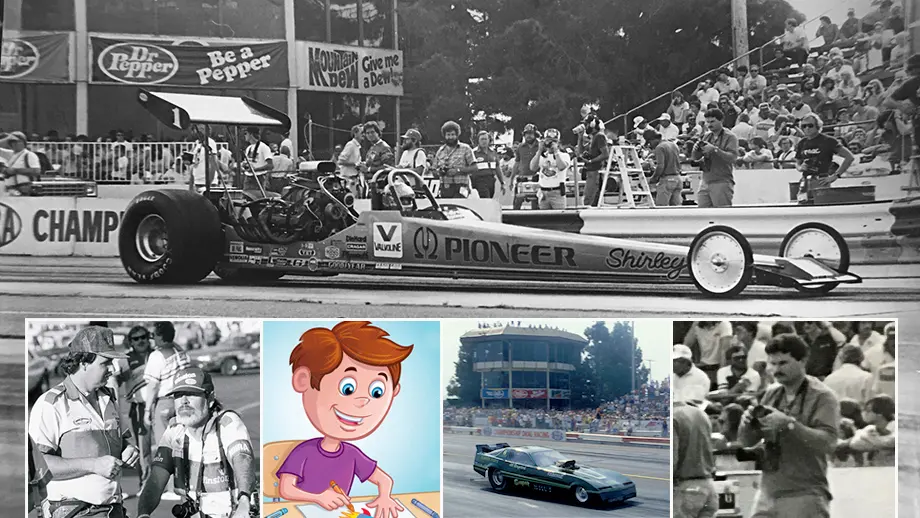
The imminent closing of Atlanta Dragway after last weekend’s running of the final NHRA Southern Nationals brought back instant memories of the grief myself and my fellow Southern Californians went through with the closings of Lions Dragstrip, Irwindale Raceway, and Orange County Int’l Raceway in the 1970s and ‘80s.

The Atlanta track was built in 1975 by Gene Bennett and originally had been graded out for an airport. When NHRA first came there in 1981, and the notorious Norman “Moose” Pearah was the owner, it was still known as Atlanta International Dragway then later renamed The New Atlanta Dragway after Pro Stock racer Gary Brown bought it in 1987, then later shortened to just Atlanta Dragway. The iconic old tower shown above was replaced with the current modern structure in time for the 1991 event.
The modern towers as we know them today didn't come into existence until the mid-1980s, led by the revolutionary Texas Motorplex, and Lions, Irwindale, and OCIR were all long-shuttered by then, though OCIR's trademark tower was the height of style and luxury from when it was introduced in the late 1960s.
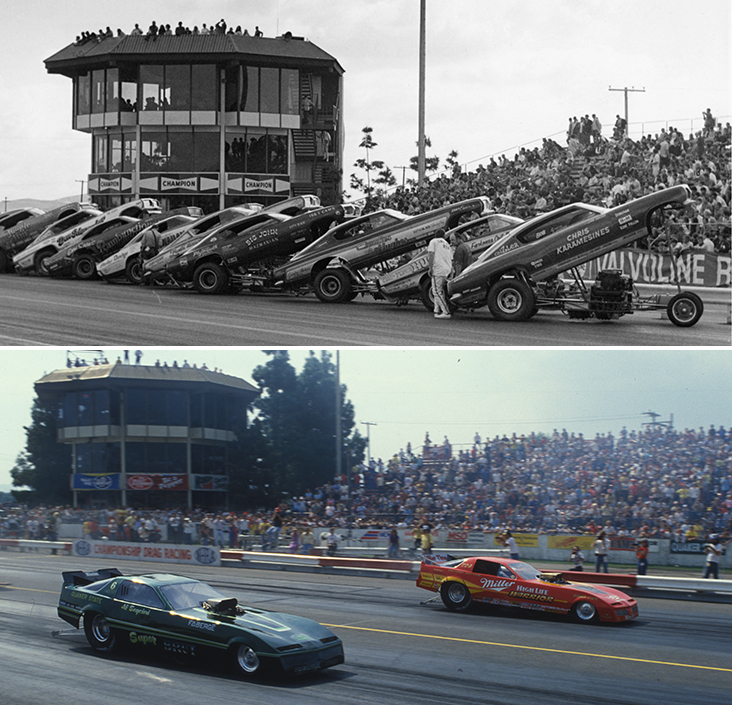
OCIR never really changed over the years, looking in 1983 almost as it did in 1967, but I have such great memories of being there, especially after joining the NHRA National Dragster team in the summer of 1982, instantly transferring me from grandstand fan to ringside insider, conferred with treasured starting-line photo access, and, boy, did I take advantage. OCIR was still running huge monthly shows from then until it closed at the end of 1983, and I don’t think I missed many from the summer of 1982 through the end of 1983, including the fabulous 1983 season (two 64 Funny Cars events and The Last Drag Race!).
For me, one of the coolest things was being able to meet and mingle with the great photographers whose images I had drooled over in drag mags since the early 1970s: Jim Kelly, Steve Reyes, Bob McClurg, Tim Marshall, Jon Asher, Jere Alhadeff, Alan Earman, John Shanks, Paul Sadler, Barry Wiggins, Don Gillespie, Richard Shute, and Dave Kommel, just to name a few. Being accepted by them was as important to me as being accepted by the racers. A lot of these guys had been palling around for years to NHRA and AHRA national events and match races, and I really wanted to become one of them.
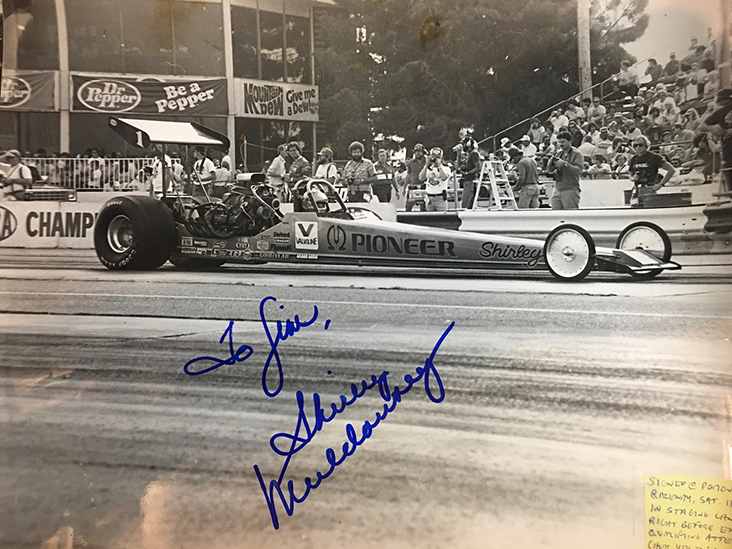
The genesis for this column (as if I ever really need an excuse to talk about OCIR) was the photo above, sent to me by Insider reader James Gledhill, who brought the world the brazen "Bernstein Busters/Dethrone The King" T-shirts at the height of Kenny Bernstein’s long string of Funny Car championships in the late 1980s. James had somehow spied a young Phil in the photo watching Shirley Muldowney in round one of the World Finals at OCIR.
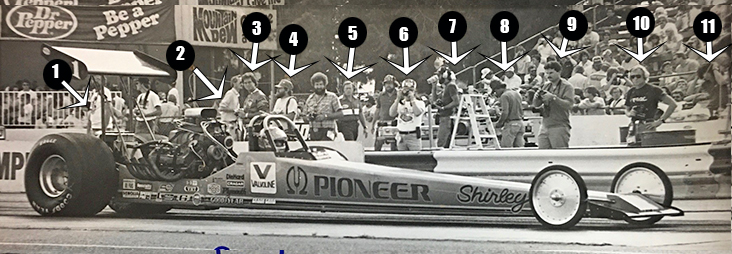
Shute helped me ID some of the guys in the photos, most of which became lifelong friends. 1: Richard Brady, the lanky Midwesterner and Division 3 Photographer who for years shot for National Dragster; 2: Andy Wilsheer, who traveled (and still does) from his native England to attend events; 3: the late, great Stevie Collison, editor of Super Stock & Drag Illustrated; 4: McClurg, one of the deans of West Coast photography; 5: “Topper” Nurrenbock, NHRA’s security guy, who stringently patrolled the photo area; 6: John Ayriss, a longtime OCIR photographer; 7: Bill Hurst, the tall, bearded New Jerseyan who also assisted ND photographers at select national events; 8: Ron Lewis, who shared his extensive collection with the Insider column not long ago; 9: yep, that’s me; 10: Don Ewald, former Top Fuel racer best known today as the curator of the We Did It For Love website; and 11: Asher, longtime Petersen Publishing legend and creator of gems like “The Garage Photo.”
When I entered their world, I had fancied myself quite the photographer, burning through endless rolls of Kodachrome from the stands, creating what I can honestly say now were crappy photos, but occasionally, I managed to accidentally get a few prized ones that I proudly placed in my scrapbooks.
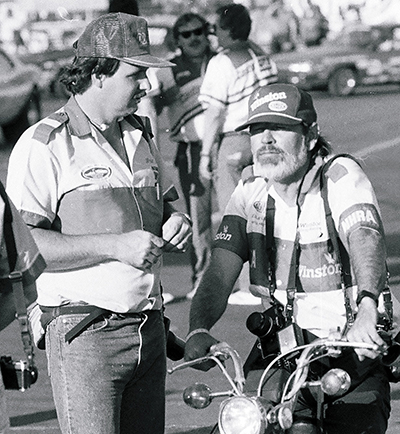
The first race I ever shot for Dragster was the Summer Showdown at OCIR in 1982. Lil John Lombardo won the race, and I remember proudly turning in my rolls of film (Tri-X black and white, because we hardly ran any color back then) to our photo czar Leslie Lovett and anxiously awaiting the proof sheets and the kudos sure to come my way. I’ll never forget his comments when he handed them to me: “Boy, you weren’t very good to Lil John,” meaning that I hadn’t gotten any good pics of the winner, other than the final round of the two cars staged at the starting line.
While I had been hired by Wally Parks himself mostly for my encyclopedic knowledge of the sport, I had told the staff that I also was pretty handy with a camera, and I had just about failed the first big test.
Fast forward to the World Finals later that year. I was determined to show ol’ Double-L that I had the right stuff in addition to the write stuff. Because this was a “home race,” the entire ND staff attended, and I wasn’t needed to shoot starting-line photography.
I set myself up on the big berm that paralleled the top end on the right side and proceeded to shoot some of the most unusable photos in the history of National Dragster photographers. For whatever reason, I thought that by setting my camera up on a tripod and pointing it at the finish line I’d get some swell photos. I had the shutter speed set at the recommended 1/500th of a second, but it never occurred to me to follow the cars as they passed, known as panning. Even though the Top Fuelers were only going mid- to high-250 mph then, most of my images were either blurry, out of focus, or both.

The only shot that I got that went into the magazine was of Frank Bradley tricycling through the traps after losing the front wheel just off the starting line against Gary Beck. Nailed that one. Of course he was only going 82 mph. How could I miss?
I got better as time went on. Lovett let me use some of his older Nikons, and that changed everything. I had been using a bottom-tier Ricoh with lenses that had all the focal clarity of hazy mayonnaise spread on the glass, and the right equipment made a difference. On smaller national events, I shot the starting line with Leslie or Bill Crites, and at bigger events, where we had more photographers, I got to shoot the top end, where I became pretty proficient (but not Steve Reyes-proficient) at capturing images when things went bad. I’ll share some of those great moments in a future column.
As I mentioned previously, starting-line photo access at any track, let alone a national event, was a treasured thing, and there was no shortage of folks trying to sneak down to the line for even one photo before being busted.
The Shirley photo above was captured by Mr. Gledhill by doing just that. Here’s his story, which we can share now because a) you’d never get away with it today (all photographers have to wear purple media vests), and b) the statute of limitations has expired.

“I was using bogus credentials (Fremont from previous week) that Don Gillespie gave me (we worked together at Bobby McGee's in Long Beach, Calif.). I actually used a crayon to recolor my credential to match what was pasted on a sandwich board next to the security guard near the scoreboard. Worse yet, I put it in a SANDWICH BAG, because I didn’t even have a credential holder!
“Of course, I had my buddy in tow, and we were so amazed he let us trackside that we didn’t know where to go. Every photog was on the other side of the track, for obvious reasons (sun), but the first round of Top Fuel was just starting, so we scampered to the rail on the parking lot side seeking cover. We pulled out our consumer-grade SLRs w/70-210 lens and tried to stop shaking enough to shoot.
“Worst of all, we walked downtrack to about 500 feet — again an instinct in our foolish, barely 18-year-old minds to get away from scrutiny. We were in a terribly dangerous spot tucked right in the guardrail. Somehow we weren’t detected until the middle of R1 Funny Car. Somebody higher up from the War Dept. at NHRA came marching towards us with eyes of fury. He asked to see our credentials, and you can imagine his disgust when he grabbed a Glad bag with a crayon-colored credential from the Golden Gate Nationals inside. He said some not-so-nice things to us as he escorted us away. But we had the presence of mind to cross behind the starting line (no pit passes, of course) and spent the afternoon reveling in our semi-successful mischief.

“I believe to this day that I was singlehandedly responsible for upgrading NHRA credential security, so tell the boss ‘you’re welcome’ for me.”
James’ story resounds with me as I also used some dubious credentials to get on the starting line at Irwindale Raceway in 1977 just before it closed. You can read that harrowing tale here.
James also shared a couple of other great anecdotes with me, including his own Irwindale angle.
“Irwindale was torture for me,” he wrote. “We lived in Arcadia, so I could hear every nitro burnout and run when the wind was blowing right. We went to our share of races there, but I remember giving my dad the stink eye when we’d hear them while eating dinner. He wanted to be there, too, but I think my mom had him on a short leash. We used to sneak into Irwindale in the back of Johnny Egan’s conversion van: Five kids under a big tarp in the back like we were going to the drive-in.
(Look out, James. Pat "Ma" Green, who ran credentials at Irwindale, is probably going to come after you as she did me when I told my story. Hi Ma! Happy Mother's Day!)
“The only time I ever went with a tow/chase vehicle to the starting line was with Lou Gasparrelli in ‘82 or ‘83 at OCIR. My buddy knew his son from school. I’ll never forget the visceral thrill of that experience. And I remember us hauling ass in the back of the dually down to the top end, as the chirping and lights of the grandstands quickly descended into quiet blackness past the finish line, only the sound of cool coastal air rushing past my ears. And then in the darkness, a smoking BB/FC appeared, snorting and hissing with Lou still sitting inside. I imagine the drivers miss those crazy 10-second bookends at match races. At one end, complete chaos of the launch, and at the other sitting in quiet, solitary darkness for a few seconds. What a juxtaposition!
“At [OCIR’s] Last Drag Race, my buddy and I were lowering the American flag while the final pass was happening. We successfully detached it and stuffed it in his jacket and took two steps before a security guard repossessed our treasured souvenir.”
Man, isn’t that what drag racing is all about? Souvenirs and keepsakes (well, maybe not American flags), even if they’re just in your mind. I still have old ticket stubs and programs and event T-shirts and various mechanical detritus picked up in pit areas (and, of course, photos) to help remind me of those days. I’m sure I’m not alone. I’d love to see some of your souvenir collections. Hit me up at the address below.
Thanks for reading along. If your mother is still with us, please celebrate her on Sunday as I will my own dear mom. If your mother passed, I’m sorry for your tremendous loss, but send a good thought her way. Either way, thank them for all they did for you, even if they wouldn’t let you out of dinner to go to the drags.
Phil Burgess can reached at pburgess@nhra.com
Hundreds of more articles like this can be found in the DRAGSTER INSIDER COLUMN ARCHIVE



















































